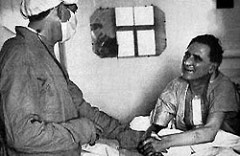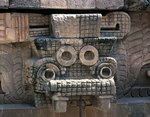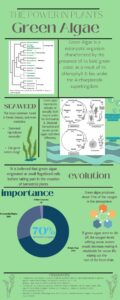“Life to me is so very valuable that I doubt if a minimum time limit can be set on it.” –Christiaan Barnaard1
What does the beat of your heart sound like? It sounds pretty much like any other heart, right? What if this heart was not your own? What if this heart had belonged to someone else before you? The sound isn’t so ordinary anymore now is it?

On December 2, 1967, twenty-five year old Denise Darvall and her mother were crossing the street trying to get to a well-known bakery. The mother and daughter were making their way to the car with the pastry in hand when the unthinkable happened. A drunk driver, paying no attention to his surroundings and running a red light, sped through the crosswalk, taking out the two ladies in his path. Denise’s mother was killed on impact, and upon arrival at the hospital, Denise would be declared brain dead.2 Her father made the decision on her behalf to save the life of another individual and give someone else another chance to live. Denise and her mother fell victim to this reckless act and ultimately lost their lives. Denise had now past away, but her death would not be in vain. Though she may not have known, Denise would become a part of medical science history.
Dr. Christiaan Barnard was born in the year 1922, and received his education at the University of Cape Town in 1946. After receiving the training necessary to become a surgeon, Christiaan helped develop an open-heart surgery program at the hospital where he worked, Grute Schuur Hospital.3 He had also had help from Stanford University to perfect his surgical techniques.4 Christiaan Barnard had numerous accomplishments under his belt already, but there was still some work that had to be done. Dr. Barnard wanted to change the world and do the unthinkable. With patients Louis Washanky and Denise Darvall, he’d be able to do just that.

Fifty-three year old Louis Washanky was a grocer in the city of Cape Town, who had been afflicted with serious heart problems. He was quite the odd choice to be the first patient for this procedure, considering he had a history of smoking and he was also diabetic.5 Additionally, he had a massive growth on his leg that would require draining and would also be another location where infection would take place. Louis was far from being the ideal choice for a first heart transplant recipient, but nonetheless, Dr. Barnard saw something in Louis and knew that he was to be the one who would receive the new heart and get a second chance at life. Denise had been declared brain dead, but she had also been deemed an ideal donor for the impending surgery for Louis. Therefore, since she was seen as selected donor, her organs could not be allowed to become deoxygenated. So her body temperature was regulated and she was kept on a ventilator so that oxygen would still be provided to her organs to keep them functioning. Denise had the blood type O and Louis had the blood type A. This meant that Denise was viewed as a “universal” blood donor and therefore Louis could receive her blood.6 However, just because the blood types were compatible did not mean that their white blood cell types were compatible. Due to the time sensitive procedure, there was no time to determine whether Louis’s body would reject the new organ. The doctors could only move forward with the procedure and hope for the best. Louis was in the room right next to Denise’s, and once the okay was given, the historic surgery was ready to begin.
Shortly after two in the morning on December 3, 1967, the surgery was ready to take place. Denise’s body had been properly prepped for the procedure and Louis had been anesthetized. Denise’s heart had been clamped and was ready for removal and Louis’s heart had been clamped so that all the blood in his body was being directed everywhere except to his now failing heart. Once Denise’s heart was removed, it was directly put on ice and was being pumped with blood so as to keep the organ alive, whereas Louis’s heart was to never beat again. The surgeons carefully moved the donor heart into its new home and stitched the organ in like a puzzle piece. They carefully attached the aorta, the pulmonary artery, and each and every vein. The delicate procedure took an estimated four hours to complete. The moment of truth would come when it was time for the heart to beat for the first time. All hands were off the body and Dr. Barnard would shock Louis’s chest to see if the risky surgery was too good to be true. Dr. Barnard shocked Louis’s chest, and sure enough…lub-DUB, the heart began beating on its now.7

Louis had survived the surgery and he now had a properly functioning heart, but he wasn’t out of the woods yet. He had won half the battle, but their still were no guarantees as far as Louis’s outcome would go. Now the hurdle that had to be crossed was to see if Louis would continue to survive and see if his body would handle the sudden, drastic change of a new organ. Upon Louis’s first time waking up, he appeared to be doing fine and feeling good. He was smiling and was very grateful for the second chance at life that he had been given. Dr. Barnard was overjoyed to see his first patient doing so well, but he knew that there was still a long way to go. In the coming days, Louis had seemed to be making progress and continuing to heal more each day. About two weeks after the surgery, however, Louis had taken a turn for the worse. His caretakers were uncertain as to what caused the sudden decline in health. They deemed the issue to be attributed to their worst fear: organ rejection. The caretakers decided to increase the treatment for organ rejection, which ultimately would cause Louis to become more immuno-compromised. This means that his immune system would be lowered to the point where his body could no longer fight off infection or defend itself from any potential invaders of his body. While the intentions of this action were for the benefit of Louis, the step taken to help him actually ended up being detrimental to his health. The increase of medication actually worsened his condition rather than help it. Due to his compromised immune system, Louis continued to deteriorate and he ended up contracting pneumonia, from which he unfortunately could not recover. A little over two weeks after receiving his new heart, Louis Washanky passed away due to the complications following his surgery, combined with the deadly pneumonia.8
Though Louis unfortunately passed away, his operation was still considered a success. The procedure was something that had never been done before and Dr. Barnard’s patient lived for over two weeks with the new heart. The operation would set the stage for future heart transplants to take place with even more of a success rate. From Louis’s surgery and post-op conditions, healthcare providers could learn from the operation both what went right and what went wrong. That way they could provide the best outcome possible for their patients. Dr. Barnard took a chance with this new procedure, but he opened the doors for future surgeons and patients alike to have this second chance like Louis Washanky had been given. Dr. Barnard took a chance on the procedure, and by doing so, he also helped other surgeons have the bravery to take a chance on new, life-saving surgeries as well. Of course, Denise Darvall cannot be forgotten in all of this. Though what happened to her was tragic, she helped to give Louis Washanky another two and a half weeks of life that he may not have had without her help. Her contribution can never be forgotten since the breakthrough surgery would not have been possible without her. Denise quite literally gave the most loving gift of life to Louis Washanky straight from the heart. Although bittersweet, due to the story of these three individuals and all others involved, the history of medicine was changed, and medicine today has advanced due to the sacrifices and chances taken by these brave people.
- Christiaan Barnard, Heart Attack: You Don’t Have to Die (New York: Delacorte Press, 1971), 5. ↵
- James Brent-Styan, “PART 2: First Heart Transplant-‘Denise never saw the motor vehicle coming,’” news24. Accessed November 8, 2018. https://www.news24.com/Books/part-2-first-heart-transplant-denise-never-saw-the-motor-vehicle-coming-20171203. ↵
- John Brink and Johannis Hassoulas, “The first human heart transplant and further advances in cardiac transplantation at Groote Schuur Hospital and the University of Cape Town,” Cardiovascular Journal of Africa Vol. 20(1) (2009): 31-35. ↵
- “A Brief History of Heart Transplantation,” Columbia Doctors, accessed September 9, 2018. http://columbiasurgery.org/heart-transplant/brief-history-heart-transplantation. ↵
- John Brink and Johannis Hassoulas, “The first human heart transplant and further advances in cardiac transplantation at Groote Schuur Hospital and the University of Cape Town,” Cardiovascular Journal of Africa Vol. 20(1) (2009): 31-35. ↵
- Lily Rothman, “50 Years Ago This Week: Inside the First Heart Transplant,” Time, December 11, 2017. Accessed September 9, 2018. http://time.com/5050803/1967-heart-transplant/. ↵
- Lily Rothman, “50 Years Ago This Week: Inside the First Heart Transplant,” Time, December 11, 2017. Accessed September 9, 2018. http://time.com/5050803/1967-heart-transplant/. ↵
- John Brink and Johannis Hassoulas, “The first human heart transplant and further advances in cardiac transplantation at Groote Schuur Hospital and the University of Cape Town,” Cardiovascular Journal of Africa Vol. 20(1) (2009): 31-35. ↵



58 comments
Alin Bocardo Felix
The first heart transplant was conducted nearly 53 years ago, which although doesn’t seem much, I would have thought the first surgery of that sort would have been a lot more modern. Thanks to Dr. Barnaad, science changed forever for hundreds of people, had this never happened. countless people would die everyday from heart complications and minor organ issues. Although not stated if this heart transplant was the first organ transplant of any sort, it was still very advanced. The article was well written and very descriptive, it encompassed everything surrounding the situation.
Angelina Gonzalez
I had never thought of how these medical discoveries came to be. It is sad how it happened, but I am a strong believer in things happening for a reason. I think Denise’s death was for a reason, with her heart history was made. This article was very informing to read and makes me curious of what the stories are like for other discoveries.
Nicole Ortiz
I never knew that the first heart transplant surgery happened this long ago. I always thought that it was something that was more recent but I would say that this first surgery was bittersweet. This is due to the fact that Louis was given another chance at living life but unfortunately, his body rejected this new heart that could have given him a longer life. Oftentimes, the worst situations can be fruitful for others and in this case, the death of Denise was the reason why Louis even had the possibility of another chance to live longer. I always like to give credit though to the surgeons that make procedures and surgeries like these even possible because i know that since it was the first time that anything like this was being done, Dr. Barnard had a lot on his hands and the good thing is that this surgery ended up being successful the first time that it was ever done.
Isabella Torres
Although Louis did not end up surviving due to complications, his surgery really paved the way for future heart transplants all over the world. The majority of the treatments and surgeries we have in the medical world today have failed at some point early on, but the failures were necessary in order to determine what needed to be fixed or adjusted to make the treatments completely effective. This article had a lot of great information and I definitely learned things that I didn’t know before, such as the fact that the first heart transplant took around 4 hours; for some reason I thought it took way longer.
Eliezer Leal
Modern medicine is an amazing thing, the lives saved on a daily basis is an incredible feat that many like myself consider a miracle. Although the path taken to get to the advanced life saving treatments we have today was rigorous and costly in a sense that lives were lost through unintentional trial and error to perfect these procedures. I am not pointing fingers or blaming anyone about this and do not intend to offend I am just agreeing with the article that getting to where we are medically was only because of risk taking in trying new procedures, but ultimately I am grateful to those who took the risks needed in order to safely perform these procedures.
Ashley Martinez
This article was very touching and heartwarming. These stories are the many reasons that I have as to why I want to go into the medical field. It is devastating to see that Denise Darvall and her mother lost their lives due to a selfish drunk driver. Denise was brain dead, and her father made the decision to allow Denise to be an organ donor. Dr. Christiaan Barnard was a surgeon and had a patient by the name of Louis Washanky. Louis had suffered from heart issues and was not necessarily the best candidate for a newly donated organ because he was a heavy smoker, suffered from diabetes and even had a large wound . Dr. Barnard believed that Louis would be able to live a long life after the transplant. Louis died two weeks after the transplant because he had contracted pneumonia. Louis was the first patient ever to receive a heart transplant so this was a huge breakthrough in the medical field and has been very influential to this day. It is amazing that transplants for all organs can be done for those patients that need them. I really enjoyed reading about this article.
Sebastian Azcui
I find it very interesting how the first heart transplant was made and what procedure did they follow. A long time ago it seems like a almost impossible procedure as the tools used were different and they did not have too much technology. It’s amazing to read that the patient lasted two weeks after the heart transplant because it was a success for him to be alive. But, he died, so something was wrong. I would like to read more and have more details as of how the surgery was done and what other procedures to they have to do.
Hannah Hennon
I never thought about what the first heart transplant was like. It is crazy to think that the guy who got the first heart transplant only died two weeks later. The story honestly is a little sad, but someone had to be the first to receive the heart transplant and go through with this procedure. This article gave me a good background about the topic, but I wish there were a little more details in the article.
Bruno Lezama
I found this article very interesting. I think that this operation had a lot of importance to the medical community due the fact that nowadays the heart transplant is something that gives people a second chance to live. I impressed about the work of Dr. Christiaan Barnard because he took the risk to did that operation which long 4 hours. Thanks to de donator, Denise Darvall, Dr. Barnard could do this operation. Unfortunately, the person who received the heart, Louis Washanky, passed away after two and a half weeks of the operation. However, this was a big step to the history of medicine.
Amariz Puerta
This article was very very interesting to me I really enjoyed how they took such a popular major in school and turned it into this great article. It really interested me because I have always had a passion for medicine and I have always wanted to do that as a career. This article really highlighted what the first heart transplant was like, it almost felt as if I was there. I really enjoyed reading this article.